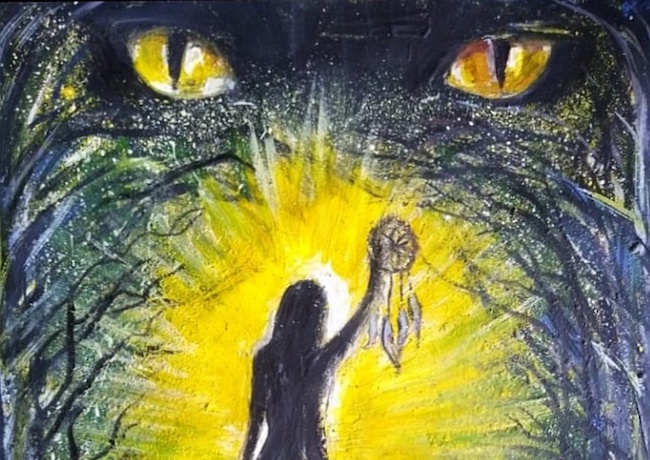Raccontare la propria interiorità, che si trasforma in personale punto di vista sull’osservato è una delle principali peculiarità dell’arte moderna e contemporanea, anche laddove l’intenzione non è quella emozionale bensì, al contrario, logica, mentale; in ogni caso l’individualità dell’artista, il suo pensiero filosofico, il suo approccio pittorico o scultoreo non poteva e non può fare a meno di fuoriuscire dalle tele. Nel caso in cui la tendenza dell’artista sia quella di lasciar emergere e parlare il mondo delle sensazioni più profonde, spesso il mezzo o la perfezione stilistica perde importanza davanti all’intensità e al significato che desidera imprimere sulla tela. La protagonista di oggi svela un’attitudine a filtrare tutto ciò che il suo sguardo coglie interpretandone, a volte anche modificandole, le connotazioni originarie che danno così vita a un universo parallelo fatto di creature magiche e affascinanti, e a volte misteriose.
Quando agli inizi del Novecento l’esigenza di liberare le emozioni imbrigliate dalla tecnica pittorica tradizionale divenne irreprimibile sorse principalmente in Nord Europa, sebbene si diffuse poi in tutto il vecchio continente, un movimento pittorico che rifiutava ogni tipo di regola o di schema esecutivo, qualunque cosa che distraesse l’artista esecutore dal contatto istintivo con le sensazioni, dallo sguardo verso la propria interiorità e dal significato che il sentire personale potesse dare al visibile intorno al soggetto. L’Espressionismo, questo il nome della nuova corrente pittorica, rifiutando il comune senso del bello, l’armonia della prospettiva e della profondità, i dettagli estetici dei personaggi o dei panorami immortalati, si poneva come obiettivo prioritario quello di lasciare sulla tela i segni dei moti interiori, le ansie, le angosce o semplicemente un mondo di sensazioni che voleva fuoriuscire con tutto l’impatto emotivo percepito nel momento della creazione dell’opera. Per alcuni artisti, in particolar modo per i rappresentanti del Nord Europa di questa corrente nata sulle ceneri di un primo tentativo compiuto dai Fauves di creare linee comuni che potessero dar vita a un gruppo artisti, l’emozione dominante era l’angoscia, l’ansia, l’incubo dell’incertezza di un vivere insopportabile per la sua destabilizzazione, come nelle tele di Edvard Munch; per altri invece a essere protagonista era il desiderio di fuga dalla realtà, della rappresentazione ingenua e immediata di un ambiente naturale in cui la mente potesse lasciarsi andare e distogliersi dal suo disagio, come nel caso di Vincent Van Gogh, o in cui sognare un mondo più puro, distaccato dalle dinamiche sociali e dall’ipocrisia borghese come nel periodo polinesiano di Paul Gauguin. E poi c’è stato Marc Chagall, ebreo di origine russa che con le sue opere è riuscito a far volare la fantasia dipingendo un mondo ideale, fatto di buoni sentimenti, di armonia e leggerezza che contribuirono a far sognare gli appassionati grazie all’ingenuità e all’immediatezza che caratterizzava i suoi paesaggi, i suoi personaggi e il loro vagare sopra le città come sospesi in un universo di gioia. Il fatto che spesso i protagonisti delle sue tele fossero lui e sua moglie contribuisce a rendere ancor più affascinante il suo personale modo di guardare la realtà con gli occhi di un bambino.
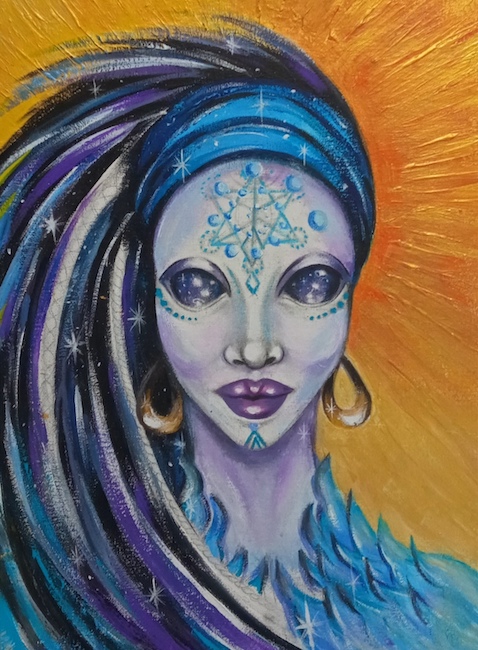
L’artista russa Yulia Savelyeva ha in comune con il grande maestro del Novecento l’inclinazione a osservare tutto ciò che la circonda con lo sguardo fanciullesco di chi necessita mettersi in contatto con le proprie emozioni in maniera libera, naturale, senza alcun filtro razionale, senza preoccuparsi dell’attinenza con una realtà che in fondo già nel vivere quotidiano viene interpretata attraverso il proprio punto di vista, il personale mondo emozionale; a maggior ragione per lei per cui la manifestazione artistica costituisce una vera e propria connessione con quel sottile mondo magico che avvolge la natura e tutte le persone che incontra nel suo cammino e che colpiscono la sua immaginazione in virtù di uno sguardo, di una particolare movenza o di un dettaglio che inconsapevolmente emerge.
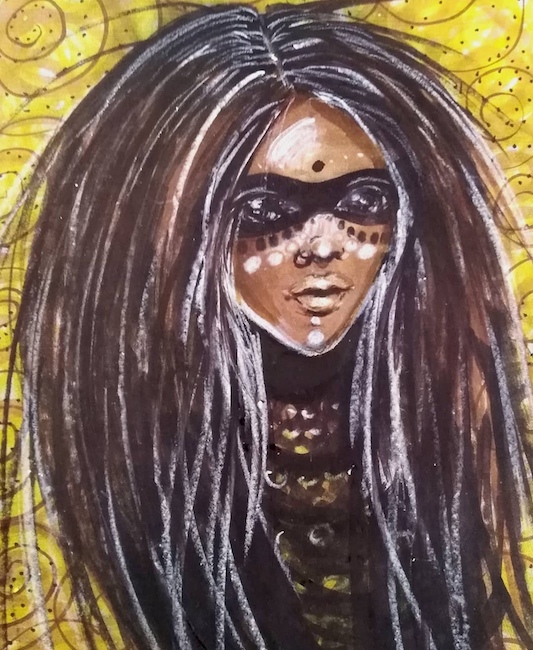
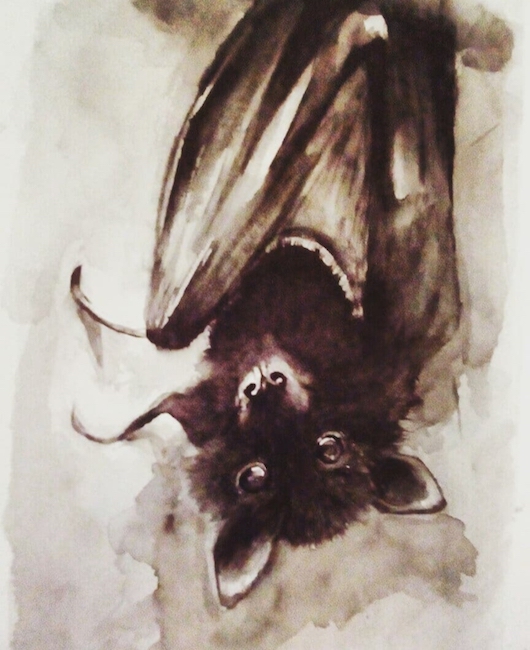
L’universo narrato dalla Savelyeva sembra costituire una dimensione parallela, a metà tra l’incanto dei racconti fantasy e le atmosfere misteriose e cupe del gotico, attraversata da animali notturni come il corvo e il pipistrello che lei interpreta nella loro essenza più profonda dunque non dal punto di vista inquietante o cupo a cui spesso vengono associati bensì osservandoli come creature innocenti che solo per uno scherzo della natura hanno assunto le caratteristiche che hanno indotto l’uomo, poco incline a un attento ascolto, troppo impegnato a dare un significato a tutto nella convinzione di essere nel giusto piuttosto che aprirsi a considerazioni differenti, a definirli con connotazione negativa. Il pipistrello è protagonista dell’opera Sogno, dunque un titolo positivo come se quello stare a testa in giù non rappresentasse l’appostamento che in passato tanto era temuto bensì semplicemente una posizione di riposo del piccolo mammifero, durante il quale probabilmente percorre lo stesso itinerario inconscio e istintivo di qualsiasi altro animale; la scelta di utilizzare l’acquarello probabilmente è stata guidata dal desiderio della Savelyeva di metterne in evidenza la leggerezza, quella qualità troppo spesso trascurata, di riuscire a sfidare la gravità del peso del proprio corpo. Forse in qualche modo il sogno di cui l’artista racconta è il medesimo dell’uomo di riuscire a superare le zavorre che contraddistinguono la sua vita e alleggerirsi riuscendo anch’egli a elevarsi verso un domani più sereno.
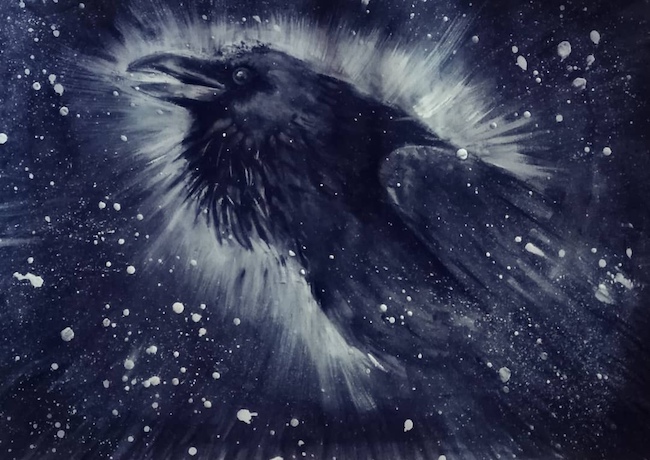
L’opera Corvo mette in evidenza l’uccello quasi come se stesse vegliando, come se stesse salvaguardando l’essere umano con quella luce soffusa che contorna il nero del suo piumaggio e che volge al positivo la sensazione che l’osservatore riceve; il suo sguardo è benevolo, rassicurante, come a suggerire che la sua reputazione di creatura legata all’oscurità non gli appartenga, che tutto sia frutto solo di leggende metropolitane che nulla hanno di effettivo. Quando racconta dell’essere umano Yulia Savelyeva si sposta invece verso un altro mondo, quello fatato, lo stesso in cui le donne sono affascinanti maghe o creature appartenenti a un universo di mezzo tra realtà e fantasia, in cui tutto può essere tangibile e nel contempo scomparire in un solo attimo.
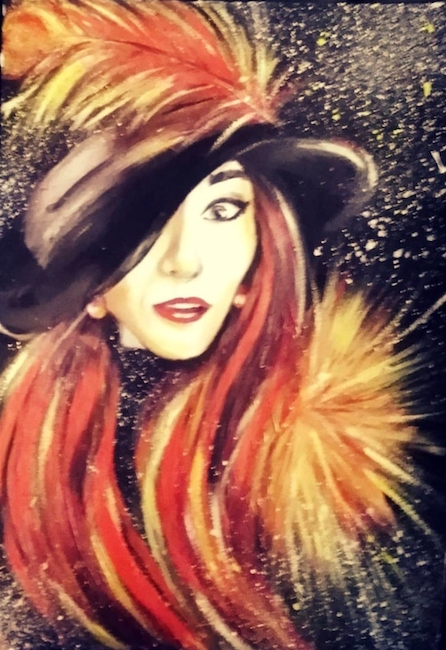
Nell’opera Phoenix (Fenice) l’artista racconta di un’ammaliante ragazza dai capelli rossi, sicura di sé proprio in virtù di quella capacità di rinascere dalle proprie ceneri che appartiene squisitamente al genere femminile, e che l’ha resa capace di acquisire fiducia nelle sue risorse e nella consapevolezza di potersi rialzare, quasi come se fosse avvolta da un’aura magica, come se il suo sguardo volesse infondere nell’osservatore quel senso di riverenza che si dovrebbe avere davanti a chi è stato capace di costruire il mondo che ha voluto. In qualche modo l’opera è una metafora dell’uomo contemporaneo che tende a inseguire solo marginalmente il proprio sogno, i propri desideri, poco incline a combattere per ciò che davvero desidera, rinunciando troppo spesso e guardando chi invece ha deciso di non desistere quasi con invidia, che è più che altro rimprovero silenzioso verso se stesso per aver scelto di desistere.
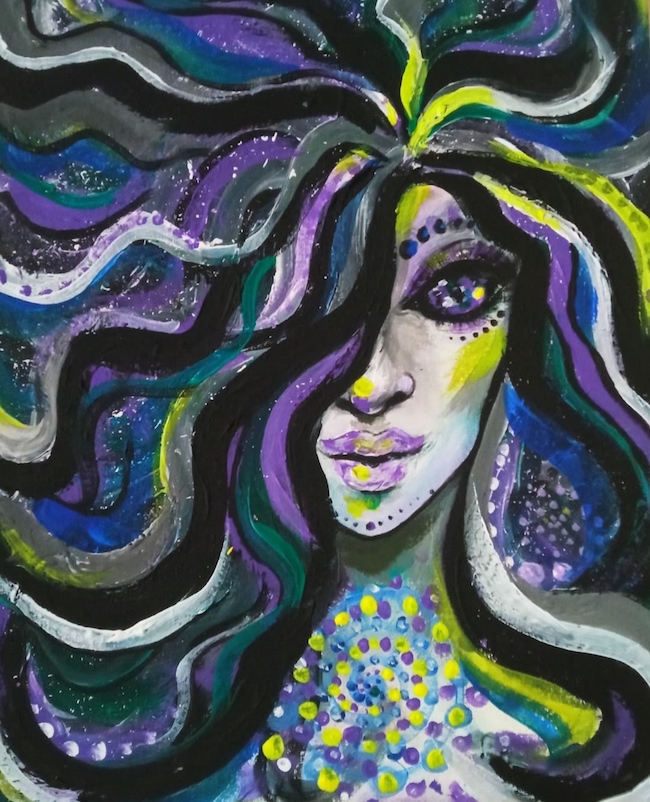
Yennefer appare invece come un’incantata Medusa, che secondo l’interpretazione originaria del nome significa colei che protegge, la Gorgone che trasformava in pietra chiunque con un solo sguardo; nel mito la donna era stata trasformata nell’aspetto dalla dea Atena come punizione per aver giaciuto con Poseidone nel suo tempio così Yulia Savelyeva ne dà all’osservatore una versione meno minacciosa, meno spaventosa e decisamente più affascinante, ritrovando l’antico significato di protettrice.
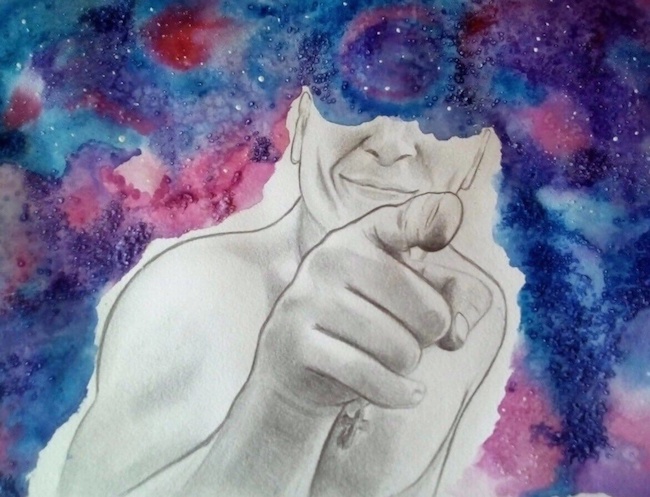
La protagonista sembra così invitare a entrare nel suo mondo per sentirsi al sicuro, e non più minacciati, a trovare una dimensione più armonica e volgere al positivo tutto ciò che spesso viene creduto essere negativo, tendenza che appartiene alla filosofia di vita dell’artista. Poliedrica e sperimentatrice Yulia Savelyeva ama mescolare i materiali attraverso cui esprime il suo particolare punto di vista in grado di tirare fuori il meglio di chiunque colpisca la sua attenzione, così come i supporti; predilige la carta sulla quale opera con colori acrilici, a olio, acquarelli, pennarelli, penna gel, a volte il sale, dando vita a opere leggere ma comunque estremamente intense, perfette per raccontare quel suo mondo fantastico all’interno del quale ama perdersi. Yulia Savelyeva espone regolarmente in Russia e all’estero e le sue opere sono in collezioni private di tutto il mondo.
YULIA SAVELYEVA-CONTATTI
Email: savajuli1983@yandex.ru
Facebook: https://www.facebook.com/SJuliaArt
Yulia Savelyeva’s Expressionism in perpetual experimentation, between love for nature and Gothic atmospheres
Telling the story of one’s interiority, which becomes a personal point of view on the observed, is one of the main peculiarities of modern and contemporary art, even when the intention is not emotional but, on the contrary, logical and mental; in any case the artist’s individuality, his philosophical thought, his pictorial or sculptural approach could not and cannot fail to emerge from the canvas. When the artist’s tendency is to let the world of deepest feelings emerge and speak, the medium or stylistic perfection often loses importance in front of the intensity and meaning he wishes to imprint on the canvas. Today’s protagonist reveals an aptitude for filtering everything that her gaze catches, interpreting, sometimes even modifying, the original connotations that thus give life to a parallel universe made up of magical, fascinating and sometimes mysterious creatures.
When, at the beginning of the twentieth century, the need to free the emotions harnessed by traditional painting techniques became irrepressible, a pictorial movement arose mainly in Northern Europe, although it then spread throughout the Old Continent. It rejected any kind of rule or executive scheme, anything that distracted the artist from instinctive contact with feelings, from a glance towards his own interiority and from the meaning that personal feeling could give to the visible around the subject. Expressionism, the name of the new painting movement, rejected the common sense of beauty, the harmony of perspective and depth, the aesthetic details of the characters or landscapes immortalised, and set as its primary objective that of leaving on the canvas the signs of inner movements, anxieties, anguish or simply a world of sensations that wanted to come out with all the emotional impact perceived at the moment of creating the artwork. For some artists, particularly the Northern European representatives of this current born from the ashes of an initial attempt by the Fauves to create common lines that could give life to a group of artists, the dominant emotion was anguish, anxiety, the nightmare of the uncertainty of a life unbearable for its destabilisation, as in the paintings of Edvard Munch; for others, instead, the protagonist was the desire to escape from reality, the naive and immediate representation of a natural environment in which the mind could let go and distract itself from its discomfort, as in the case of Vincent Van Gogh, or in which to dream of a purer world, detached from social dynamics and bourgeois hypocrisy, as in Paul Gauguin’s Polynesian period. And then there was Marc Chagall, a Jew of Russian origin, who succeeded in making the imagination fly with his artworks by painting an ideal world, made up of good feelings, harmony and lightness that contributed to making fans dream thanks to the naivety and immediacy that characterised his landscapes, his characters and their wandering above the cities as if suspended in a universe of joy. The fact that he and his wife were often the protagonists of his canvases makes his personal way of looking at reality through the eyes of a child all the more fascinating.
The Russian artist Yulia Savelyeva shares with the great 20th-century master the inclination to observe everything that surrounds her with the childlike gaze of someone who needs to get in touch with emotions in a free, natural way, without any rational filter, without worrying about the relevance of a reality that, after all, in everyday life is already interpreted through her own point of view, her personal emotional world; all the more so for her, for whom artistic expression constitutes a real connection with that subtle, magical world that envelops nature and all the people she meets along the way and who strike her imagination by virtue of a glance, a particular movement or a detail that unconsciously emerges. The universe narrated by Savelyeva seems to constitute a parallel dimension, halfway between the enchantment of fantasy stories and the mysterious and gloomy atmospheres of the Gothic, crossed by nocturnal animals such as the raven and the bat, which she interprets in their deepest essence, not from the disturbing or gloomy point of view with which they are often associated, but by observing them as innocent creatures that only by a trick of nature have taken on the characteristics that have induced man, not inclined to careful listening, too busy in giving a meaning to everything in the conviction of being right rather than being open to different considerations, to define them with a negative connotation. The bat is the protagonist of the artwork Sogno (Dream), thus a positive title as if standing on its head did not represent the stalking that was so feared in the past but simply a resting position for the small mammal, during which it probably follows the same unconscious and instinctive path as any other animal; the choice to use watercolour was probably guided by Savelyeva’s desire to highlight its lightness, that all too often neglected quality of being able to defy the gravity of the weight of its own body. Perhaps in some way the dream the artist talks about is the same as man’s to overcome the ballast that marks his life and to lighten up so that he too can rise towards a more serene tomorrow.
The artwork Corvo (Raven) highlights the bird almost as if it were keeping watch, as if it were safeguarding the human being with the soft light that surrounds the black of its plumage and that turns the observer’s sensation into a positive one; its gaze is benevolent, reassuring, as if to suggest that its reputation as a creature linked to darkness does not belong to it, that everything is just the result of urban legends that have nothing to do with reality. When she talks about the human being, Yulia Savelyeva moves instead towards another world, the fairy world, where women are fascinating sorceresses or creatures belonging to a universe somewhere between reality and fantasy, where everything can be tangible and at the same time disappear in a single moment. In Phoenix, the artist tells of a bewitching red-haired girl who is self-confident precisely because of her ability to rise from the ashes, which is exquisitely feminine, and which has enabled her to gain confidence in her own resources and in the knowledge that she can get back on her feet, almost as if she were enveloped in a magical aura, as if her gaze were intended to instil in the observer that sense of reverence that one should have in front of someone who has been able to build the world she wanted.
In some ways, the artwork is a metaphor for contemporary man, who tends to pursue his dreams and desires only marginally, and is not inclined to fight for what he really wants, giving up too often and looking at those who have decided not to give up almost with envy, which is more like a silent reproach to himself for having chosen to give up. Yennefer, on the other hand, appears as an enchanted Medusa, which according to the original interpretation of the name means she who protects, the Gorgon who turned anyone to stone with a single glance; in the myth, the woman had been transformed by the goddess Athena as punishment for lying with Poseidon in her temple, so Yulia Savelyeva gives the observer a less threatening, less frightening and decidedly more fascinating version, rediscovering the ancient meaning of protector. The protagonist thus seems to invite us to enter her world in order to feel safe, and no longer threatened, to find a more harmonious dimension and turn everything that is often believed to be negative into something positive, a tendency that belongs to the artist’s philosophy of life. Multifaceted and experimental, Yulia Savelyeva loves to mix the materials through which she expresses her particular point of view, capable of bringing out the best in anyone who catches her eye, as well as the media; she prefers paper on which she works with acrylics, oils, watercolours, felt-tip pens, gel pens and sometimes salt, creating artworks that are light but nevertheless extremely intense, perfect for telling the story of the fantastic world in which she loves to lose herself. Yulia Savelyeva regularly exhibits in Russia and abroad and her artworks are in private collections all over the world.


